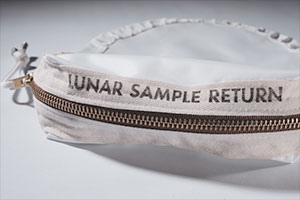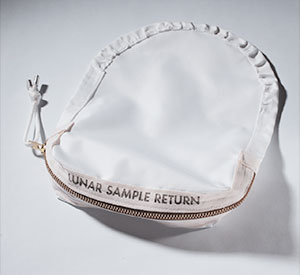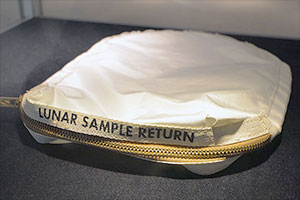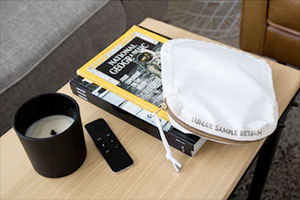February 17, 2019 — Forget the Louis Vuitton, Chanel and Gucci knockoffs, what may be the must-have high-end bag replica this summer — 50 years after the first moon landing — is a Puntzi.
Puntzi, a new design house run by the founder of the Oregon-based bag brand July Nine, chose as its first project to recreate a moon rock bag used on NASA's Apollo 11 mission in July 1969. The original, moon dust-stained bag elicited worldwide attention when it was sold for almost $2 million at an auction in 2017.
But now you can buy Puntzi's replica Apollo 11 Contingency Lunar Sample Return Bag for just $99.
Launched for sale on the Kickstarter crowdfunding website on Sunday (Feb. 17), Puntzi's lunar sample return bag is made out of some of the same materials that NASA used for the original.
"From our research we were able to determine the materials and specifications of the original bag. By using modern sewing techniques and a reputable U.S. manufacturer, we are able to create this reproduction," Garrett Loveall, the founder of Puntzi, writes on the bag's Kickstarter campaign page.
The full-size replica — the original and the recreation measure 12 inches by 8.5 inches (30 by 22 centimeters) — has a color-matched polyester binding, a Nomex zipper and is made from authentic Beta cloth. The latter is a flame-resistant woven glass fiber that NASA adopted for all of its Apollo spacecraft soft goods after a fire claimed the lives of three astronauts during a 1967 test on the launch pad.
"The only difference is yours hasn't been to the moon yet," writes Loveall.
The real bag landed on the moon with Apollo 11 crewmates Neil Armstrong and Buzz Aldrin on July 20, 1969. One of Armstrong's first tasks after taking his "one small step" was to collect a small cache of moon rocks and soil as a "contingency sample" in case an emergency resulted in a quick departure from the moon.
Armstrong collected the contingency sample in a teflon bag, which he stuffed into a pocket that was strapped to his leg for the length of the moonwalk. Once he was back inside the lunar module, he transferred the teflon bag into a white zippered pouch stamped with the label "Lunar Sample Return" to protect the rocks and soil from contamination on their trip back to Earth.
And that might have been the end of that particular bag's story were it not for an inventory mixup at a museum four decades later.
The same bag that served as a model for Puntzi's replica was (and continues to be) the subject of multiple lawsuits stemming from its improper forfeiture and sale. The bag surfaced at a 2015 auction held on behalf of the U.S. Marshals service. The winning bidder paid $995 and then consigned it to Sotheby's, where it sold for $1,812,500 million.
Between the two sales, the bag's buyer filed and won in lawsuits against NASA to assert title over the artifact.
The controversy raised by the court cases drew the public's interest, but it was the role that the bag played 50 years ago that inspired Loveall to select it as Puntzi's first creation.
"Six years ago, I launched my first Kickstarter that evolved into an international bag business that I still run today. This will be our third Kickstarter, but the first under our new brand, Puntzi," he writes. "I'm excited to blend my expertise in manufacturing with my passion for space exploration to bring this project to life."
Puntzi's Apollo 11 Contingency Lunar Sample Return Bag is limited to a one-time production run due to the logistics of having the Beta cloth cut and sewn. In addition to the $99 bag, the Kickstarter campaign is also offering 3-by-3-inch (7.6 cm square) sections of Beta cloth packaged in a sealed anti-static bag, a "perfect item to round out your space exploration collection," for pledges of $15 or more.
As for the bag, Loveall says it is up to the owners on its use.
"Whether you choose to put it on display, have as a conversation piece, or use as a functional carry-all, the Contingency Bag is up to the task," he writes.
The Kickstarter campaign, which seeks to raise $25,000 (about 250 bags), is open for one month. The bags are expected to ship in August.
For more details, see Puntzi's website or the Apollo 11 Contingency Lunar Sample Return Bag campaign page on Kickstarter. |
|

Puntzi's replica Apollo 11 Contingency Lunar Sample Return Bag recreates the pouch used to store some of the first moon rocks and soil collected from the lunar surface 50 years ago. (Puntzi)

Like the original on which it is modeled, the Puntzi replica Apollo 11 Lunar Sample Return Bag is made from Beta cloth. (Puntzi)

The original, moon dust-stained Apollo 11 lunar sample return bag sold for $1.8 million at a Sotheby's auction in 2017. (collectSPACE)

The Puntzi replica Apollo 11 lunar sample return bag can be used as a display item, a conversation piece or a carry-all. (Puntzi) |
